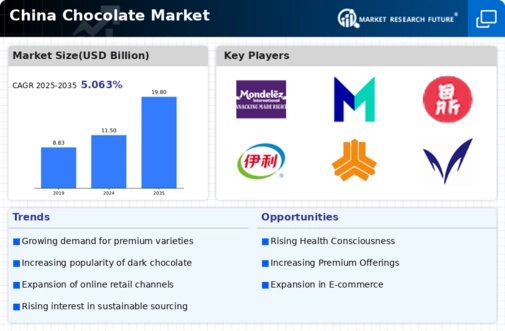Rising Disposable Income
The increasing disposable income among consumers in China appears to be a significant driver for the chocolate market. As individuals have more financial resources, they tend to indulge in premium and luxury chocolate products. Reports indicate that the average disposable income in urban areas has risen by approximately 8% annually, leading to a greater willingness to spend on high-quality chocolate. This trend is particularly evident among the middle and upper classes, who are increasingly seeking gourmet and artisanal chocolate options. The chocolate market in China is likely to benefit from this shift, as consumers prioritize quality and unique flavors over basic offerings. Furthermore, the growth of the middle class is expected to continue, potentially expanding the market further as more consumers enter this demographic and seek indulgent treats.
Growing Demand for Gifting
The cultural significance of gifting in China is driving demand within the chocolate market. Chocolate is increasingly viewed as a desirable gift for various occasions, including festivals, weddings, and corporate events. Market analysis suggests that the gifting segment of the chocolate market has expanded by approximately 12% over the past few years, reflecting changing consumer behaviors. This trend is particularly pronounced during major holidays such as the Chinese New Year, where chocolate gifts are becoming more popular. Brands that effectively market their products as suitable for gifting purposes are likely to see increased sales, as consumers seek high-quality and aesthetically pleasing chocolate options to present to friends and family. The chocolate market is thus positioned to benefit from this cultural trend, as gifting becomes an integral part of consumer purchasing decisions.
Innovative Flavors and Varieties
Innovation in flavors and product varieties is emerging as a crucial driver for the chocolate market in China. Manufacturers are increasingly experimenting with unique flavor combinations, such as matcha, chili, and various fruit infusions, to cater to the evolving tastes of Chinese consumers. This trend is supported by market data indicating that specialty chocolate products have seen a growth rate of around 15% in recent years. The introduction of limited-edition flavors and seasonal offerings also appears to create excitement and urgency among consumers, encouraging them to try new products. As the chocolate market continues to evolve, brands that prioritize innovation and creativity in their offerings are likely to capture a larger share of the market, appealing to adventurous consumers who seek novel experiences.
Influence of Social Media Marketing
The role of social media marketing is becoming increasingly pivotal in shaping consumer preferences within the chocolate market. Brands are leveraging platforms such as WeChat and Weibo to engage with consumers, promote new products, and create brand awareness. Data suggests that companies utilizing social media effectively have experienced a sales increase of around 20% compared to those relying on traditional marketing methods. This trend indicates that the chocolate market is adapting to the digital age, where online presence and consumer interaction are crucial for success. As more consumers turn to social media for product recommendations and reviews, brands that cultivate a strong online presence are likely to thrive. The chocolate market in China is thus evolving, with social media serving as a powerful tool for driving consumer engagement and sales.
Sustainability and Ethical Sourcing
Sustainability concerns are increasingly influencing consumer choices in the chocolate market. As awareness of environmental issues grows, consumers in China are becoming more inclined to purchase chocolate products that are ethically sourced and produced. This shift is reflected in market data, which indicates that sales of sustainably sourced chocolate have risen by approximately 10% in recent years. Brands that prioritize ethical sourcing practices and transparent supply chains are likely to resonate with environmentally conscious consumers. This trend not only enhances brand loyalty but also positions companies favorably in a competitive market. The chocolate market in China is thus witnessing a transformation, as sustainability becomes a key factor in purchasing decisions, potentially reshaping the landscape of the industry.






















Leave a Comment